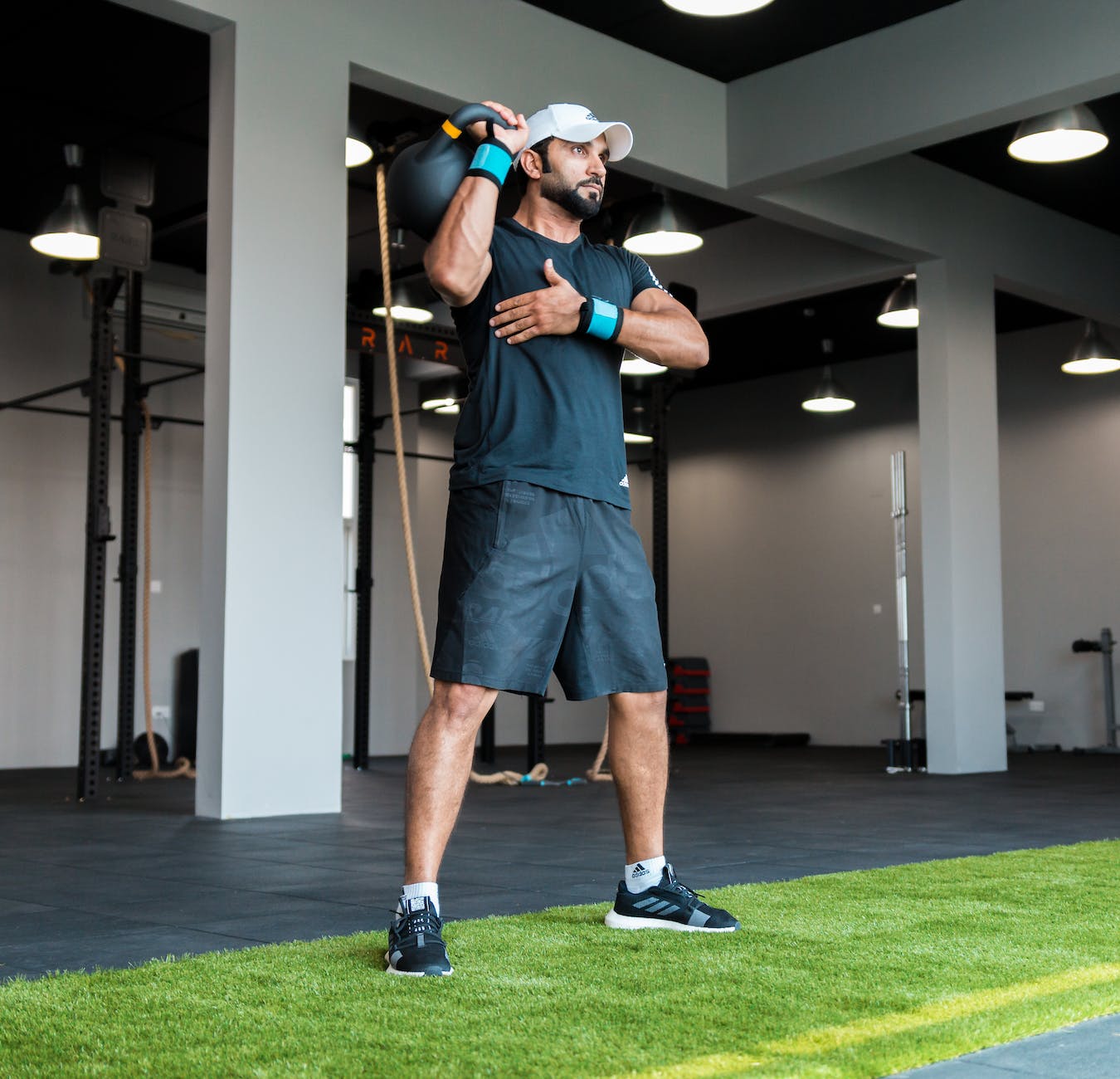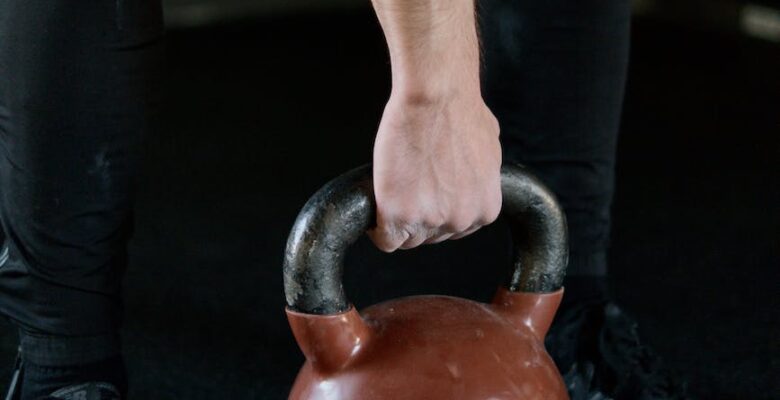Kettlebell exercises can help your complete body workout by providing a number of exercise options. Here are some exercises for your lower body with kettlebells, including squats, lunges, deadlifts, and more.
Kettlebells are a great way to improve strength, aerobic fitness, power, and functional fitness. They give weight distribution that is distinct from barbells or dumbbells and offers unique qualities for pushing your balance in unexpected ways.
Incorporating kettlebell exercises into your training program adds variation and fresh demands to your muscles, resulting in excellent results. Because the movement made with kettlebells is fluid and functional, they may provide additional benefits for protecting the back from injury.
Perform 1 – 3 sets of 12 – 15 reps of all these movements.
Swinging Kettlebells
Kettlebell swings are a one of those kettlebell exercises which conditions full-body that improves strength, power, and cardiovascular fitness. Swings specifically target your posterior chain—the muscles on your backside that include your glutes and hamstrings.
Allow enough space around you to do kettlebell swings, and make sure no one is in your way.
- Place your feet about 8 – 12 inches apart on the floor. Start by placing a kettlebell on the floor in front of you.
- Maintain a small bend in your knees while pulling your shoulder blades back and down and bracing your core as if expecting a punch.
- To grip your kettlebell, hinge your hips back and your body forward as one unit. Maintain a straight back and only a tiny bend in the knees (do not squat).
- In order to grab the kettlebell, inhale. Exhale, contract your glutes and hamstrings and drive your hips forward to rise to a standing position with force.
- The kettlebell will naturally swing up to roughly shoulder height.
- Allow the kettlebell to descend back between your legs while hinging your hips back. Maintain a straight spine and a torso that moves in sync with your hips.

Goblet Squats
Goblet squats will work your glutes, quadriceps, hamstrings, calves, and core. A kettlebell is the most common piece of equipment used for goblet squats.
It’s an excellent squat variant for everyone, including novices, because you must keep a tall back, and the front loading of the weight creates a counterbalancing effect, assisting you in maintaining perfect squat form and preventing butt wink, a potentially deadly form fault.
- Stand with your feet about 8 – 12 inches apart and your toes slightly slanted out.
- Hold a kettlebell at chest level with both hands clasped in a cupped position and elbows bent.
- With a neutral spine, brace your core and tilt your hips back, bending your knees into a squat while keeping the kettlebell close to your chest.
- Maintain a tall, upright chest when squatting, and try to lower your hips parallel to the ground (below 90 degrees). At the bottom of the squat, place your elbows inside your knees.
- Exhale and stand up, squeezing your glutes at the top.
Split Squat in Bulgaria
Bulgarian split squats work the glutes, quadriceps, hamstrings, and calves. They can aid in the correction of muscular imbalances as well as the development of stability and coordination.
- Start with standing in front of a bench, facing away from the bench, with one kettlebell in each hand or one in front of you at chest height.
- Maintain a strong core and retracted shoulder blades (back and down).
- To assist you in staying balanced, lift one of your feet and place it on the bench behind you. Your front standing leg will do the work.
- Brace your core and bend your knee, the leg that is on the ground, as you lower into a squat on that leg.
- Your torso will slightly bend forward as your right knee drops toward the ground. Maintain a uniform distribution of weight on your front foot.
- Lower your front leg till it is parallel to the ground or lower.
Return to standing by pressing through your front foot and squeezing your glutes.
Finish the necessary number of repetitions on one side before switching sides to continue.
Single-Legged Deadlift
Another unilateral exercise that works well with a kettlebell is the single-leg deadlift. This workout will activate your glutes and hamstrings, as well as your lower back and core.
- Stand tall with a kettlebell in one or both hands (the choice is yours, and each variant will present a unique challenge to your muscles and balance).
- Put your weight on the front leg that is supporting you and slip the other leg back. To maintain balance, keep one toe on the floor.
- Hinge forward to descend the kettlebell toward the floor, maintaining it close to your leg with your front leg straight or slightly bent.
- You can either lift your back leg straight out behind you or maintain your toes on the ground for balance.
- You may wish to grasp onto a rack for balance if you elevate your back leg. Move gently and deliberately.
- Pull your body back to standing using your glutes and hamstrings while keeping the kettlebell close to your leg. Return your rear leg to the floor if you elevate it.
- Make sure you have good balance and repeat all reps on one side before going on to the other.
Squat on a Rack
The racked squat is a muscle-building exercise that specifically targets your glutes, hip flexors, and quads. As you work to stabilize your weight in the front racked position, your core will light up.
- The racked kettlebell squat can be done with kettlebells in each hand or with a single kettlebell. If you’re only using one kettlebell, raise your empty hand out to the side as a counterbalance.
- Hold a kettlebell in each hand in the “racked” posture, with your elbows bent and tucked in, the bell in front of your shoulders, and your wrists neutral.
- Squat lower or parallel, depending on your mobility, by bracing your core, hinging your hips back, and bending your knees.
- To return to the beginning posture, push into your feet and elevate your hips using your quadriceps and glutes.

Squat with a Kettlebell in the Back
Back squats can be performed using kettlebells but at a lesser weight than a barbell back squat. Squats engage your entire lower body, and this kettlebell variation may activate your core even more as you fight to stabilize the weights. This kind of kettlebell exercises will definitely improve your balance.
- Place your feet slightly wider than hip-width apart. Place one kettlebell on the back of each shoulder and forearm, palms forward, elbows pointing down.
- Lower into a squat by hinging your hips back and bending your knees. Maintain a neutral spine and an upright posture with your chest.
- Continue to lower your thighs until they are at least parallel to the floor.
- To return to standing, push into your feet and forward with your hips, squeezing your glutes.
Click Here to Continue to Read on Kettlebell Exercises
